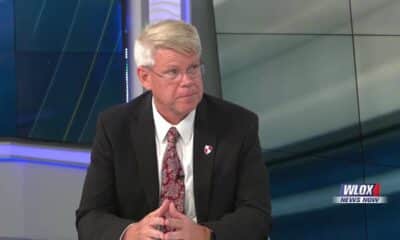Mississippi Today
New state law allows backup ambulance response in critical times
Donna Echols lost her ex-husband after having to wait 90 minutes for an ambulance to come to her Jackson home. A new law that goes into effect July 1 could prevent something similar from happening to someone else.
The state Legislature passed House Bill 1644, which the governor signed into law in April. Now, contracts between a county or municipality and a private ambulance service must allow a mutual aid agreement to allow other ambulance services to respond to 911 calls when the main ambulance service can not.
Echols was a major advocate for the bill, sharing her story with media and legislators. “What I did is talk to legislators about what happened to us and told them that it didn’t need to happen to any other family in Mississippi,” she said.
Echols says this new law gives her a sense of relief. “It will be available to help other people in their time of need,” she said.
At the local level, there’s been some backlash against AMR, the company contracted to provide ambulance service in Hinds County. An investigation by WLBT found that AMR met its contractually obligated response times around half the time. Hinds County did not fine the company for this, although it could have.
In city council meetings last summer, city leaders from Biloxi, Jackson and Gulfport discussed creating their own citywide ambulance districts.
In the fall, Hinds County successfully sued to prevent Jackson from doing so. In an order, Hinds County Chancery Judge Dewayne Thomas said Jackson’s proposal violated AMR’s contract with the county, and that switching ambulance providers would harm many Jackson residents.
By contrast, Gulfport and Biloxi faced little to no resistance. Biloxi announced its decision in December, and the Gulfport City Council unanimously approved the switch in February. Both are now serviced by Pafford EMS.
Harrison County also ended its 50-year relationship with AMR and switched to Louisiana-based Acadian Ambulance Services.
AMR referred all comments to Mississippi Ambulance Alliance board president Julia Clarke.
Clarke said that the problems with AMR are part of larger, systemic issues with the state and national healthcare system. One of the biggest is the shortage of staff.
According to the Bureau of Labor Statistics’ projections, there will be 194,500 openings for registered nurses and 20,700 for emergency medical technicians by 2030.
Last August the alliance’s board ran an op/ed in the Clarion Ledger arguing that ambulance response times were just one part of the larger problem.
“The ambulance you are waiting on is more likely than not already at an emergency room,
waiting to unload a patient at an understaffed hospital. That hospital can’t find enough nurses
to hire to care for those and other patients, meaning EMTs can’t transfer the patient in the
back of their ambulance,” the board wrote.
In April 2023, when Echols’ ex-husband, Jim Mabus, was experiencing a series of strokes, eight AMR ambulances and two sprint medics were already responding to other calls and the central Mississippi service area received six service requests, including one for a heart attack, an AMR spokesperson said at the time.
Julia Clarke said that the alliance worked with the bill’s author to make sure the wording didn’t accidentally complicate dispatch protocols. The alliance supported the bill, but Clarke pointed out that the staff and ambulance shortages would still impact response times.
“We always welcome any discussion centered on improving EMS, but we do not think it is fair to blame dedicated first responders for issues beyond their control,” she said.
This article first appeared on Mississippi Today and is republished here under a Creative Commons license.
Mississippi Today
On this day in 1954
Sept. 7, 1954

In compliance with the recent Brown v. Board of Education decision, schools in Baltimore and Washington, D.C., were desegregated. Baltimore was one of the first school systems to desegregate below the Mason-Dixon line.
A month after a dozen Black students began attending what had been an all-white school, demonstrations took place, one of them turning violent when 800 whites attacked four Black students. White parents began pulling their children out of the schools, and by 1960, the district was majority Black.
This article first appeared on Mississippi Today and is republished here under a Creative Commons license.
Mississippi Today
USM admin say program cuts are necessary to afford future pay raises for faculty, staff
The University of Southern Mississippi will look at cutting under-enrolled programs even though administrators say it is not facing a financial crisis.
The budget is balanced, despite a four-year period of decreasing revenue and increasing costs, and USM has adequate cash reserves.
The move is necessary, top leaders said at last month’s convocation, so the research institution in Hattiesburg can survive the increasingly competitive future facing higher education in Mississippi by becoming a “unicorn” among its peers, offering programs students want and the state needs.
“Colleagues, this is plain and simply the reality of where we are in higher education today, and progressive institutions all across the landscape are doing the same,” President Joe Paul told faculty on Aug. 19, according to a video the university has since taken off YouTube after faculty and staff had a chance to watch it. “We can no longer simply kick the can down the road and hope things can get better. We will instead take charge of our future and crease a uniquely positioned, distinctive public research universty of which we can all be proud and feel ownership.”
Paul added that cuts are also one of the few ways the university can afford more pay raises for its faculty and staff, some of whom will receive merit raises this fall for the first time in eight years. (After protesting, minimum wage workers at USM won a pay raise two years ago.)
“My goal for us is not to go another eight years before offering raises again, that accomplishes little,” Paul said. “If we are to develop a true salary increase plan that is competitive and sustainable, we simply must continue to do two things with discipline and consistency. One, we must all continue to grow the enrollment through recruitment and retention … while also continuing to find efficiencies and decrease spending as an institution.”
USM was able to afford the raises, which total about $4.4 million, through what Paul described as two years of systematic reductions in administrative spending. The university cut 22 unfilled and six filled positions at its Hattiesburg and Gulf Park campuses.
An increase in state appropriations also helped support the raise, but USM isn’t able to say how much because “the raises come from the university’s operating budget and the amount is not broken down by revenue source,” Nicole Ruhnke, a spokesperson, wrote in an email.
The raises addressed a significant concern for faculty at USM who held a protest for fair pay earlier this year.
Low salaries are an issue across Mississippi’s higher education system, which has struggled to attract and retain talented faculty. In recent years, the governing board of Mississippi’s eight universities has repeatedly heard how Mississippi’s faculty and staff are paid well below the average salary of other Southern states.
In an effort to fix that, the Institutions of Higher Learning Board of Trustees asked the Legislature to provide $53 million in funding this year so that each university could afford a 6.4% raise.
IHL’s spokesperson John Sewell wrote in an email that the system ultimately received $27 million in unrestricted new funding, not enough for 6.4% increase.
That funding also needed to cover other inflationary costs facing the institutions, like PERS and health insurance, Sewell wrote.
Therefore, IHL left the final decision on raises up to the institutions, so Sewell could not say how much each university spent. Plus, the system’s final appropriation bill, which IHL negotiates on behalf of the eight institutions, did not include specific language regarding raises.
“IHL did not prescribe a fixed amount of new funding to be dedicated to raises as the individual institutions needed the flexibility to balance the increased costs for PERS and health insurance along with other inflationary costs before considering the amount for possible raises,” Sewell wrote.
Those costs are also driving USM administrators’ review of under-enrolled programs, which comprise a minority of USM’s programs.
Lance Nail, the provost, is leading that effort. In response to questions from Mississippi Today, Nail and Paul did not participate in an interview but provided statements.
Nail wrote that details about the program review will be worked out in the coming weeks in consultation with faculty, staff and administration.
“We will look at each under-enrolled academic program individually in collaboration with the deans, school directors and faculty, and determine what has led to low enrollment, student and market demand, as well as other contributions the program provides within the academy.” Nail noted. “These include the program’s contributions to the general education core, pre-major requirements, research and service.”
Last fall, USM deleted three degrees after IHL’s academic productivity review, which is triggered when a program is deemed to have too few graduates in a three-year period. Those degrees were a bachelors in international studies, and doctoral degrees in music education and criminal justice.
This article first appeared on Mississippi Today and is republished here under a Creative Commons license.
Mississippi Today
Richard Lake joins Mississippi Today as audience engagement specialist
Mississippi Today is pleased to announce that Richard Lake has joined the Mississippi Today team as Audience Engagement Specialist.
In this role, Lake will work directly with journalists, editors and readers to ensure Mississippi Today’s Pulitzer Prize-winning journalism reaches every corner of the state and beyond.
“Richard has developed into a respected member of the journalism community here in Mississippi,” said managing editor Michael Guidry. “He brings such an invaluable variety of skills to our newsroom that will help us further enhance how we engage with our members and growing audience.”
Born in San Antonio, Texas, Lake graduated from Mississippi State University in 2022, earning a bachelor’s degree in journalism and a minor in political science. Richard comes to Mississippi Today after over two years as WJTV Channel 12 News‘ Senior Political Correspondent. A former Mississippi Today intern, Lake previously worked on the audience team. He also completed an internship with MSNBC’s Andrea Mitchell Reports, working as a production assistant.
While at WJTV, Lake was named a finalist for TV Rookie of the Year at the 2023 Mississippi Association of Broadcasters Awards. Lake was also a part of WJTV’s award winning reporting on Mississippi’s 2023 gubernatorial election.
“Finding creative ways to provide our audience with the journalism they expect and deserve is more important now than ever,” said Lake. “I’m excited to apply innovative strategies and work alongside this incredible team in furthering the impact of our reporting.”
This article first appeared on Mississippi Today and is republished here under a Creative Commons license.
-
News from the South - Tennessee News Feed7 days ago
Teen dead after being shot multiple times in Hermitage
-
News from the South - Alabama News Feed6 days ago
Three Atlantic disturbances remain active as the peak of Hurricane Season approaches. Tropical de…
-
Local News Video5 days ago
William Carey University enrollment continuing to increase
-
Mississippi Today2 days ago
On this day in 1955
-
Mississippi Today4 days ago
Some imprisoned in Mississippi remain jailed long after parole eligibility
-
Mississippi Today4 days ago
Mississippi regulators to solar boosters: Sit down and be quiet
-
Mississippi News4 days ago
Federal money heads to Webster County to build new jail
-
Mississippi Today6 days ago
On this day in 1975








































